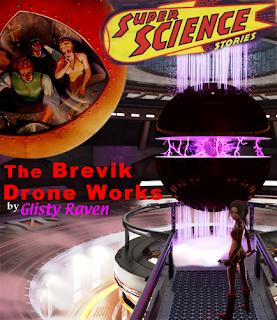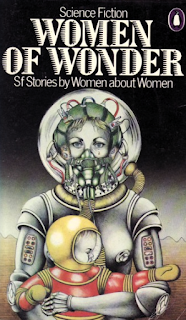Many traditional plot elements in stories of the science fiction genre offer so much opportunity for fun that authors find it hard to resist them.
Isaac Asimov wrote rather elegantly about there being no reason to believe that time travel will ever be possible, but that did not stop him from crafting stories about time travel. What about telepathy?
In "
Defense Mechanism", MacLean suggested that humans might have a form
of telepathic ability that would be selected for by evolution because it
can protect people from danger.
I'm currently engaged in my own rather drawn-out exploration of the origins of telepathy. In "
The Alastor Network", a centuries-long telepathy breeding project is coming to a culmination. In the
Foundation Reality,
R. Gohrlay and her tribe of positronic robots experimented with human telepathic networks between individuals who existed in
Nanoville. Those experimental telepathy networks involved linking together
replicoids who were experiencing sexual pleasure.
Later
Gaia and
Galaxia relied on an interstellar telepathy network among "humans" who had been genetically engineered to embody the
Laws of Robotics. Here is how the Gaian character named
Bliss described that group mind: "
At any given moment, there might be thousands of human beings on Gaia who are engaged in sex... this gives rise to a general aura of delight that [all] Gaia feels..." (page 33 in my copy of
Foundation and Earth). I have to wonder if we should call someone 'human' if they are behaviorally constrained by the Laws of Robotics. I'd prefer to call them Gaians or Galaxians, not humans as we know them.
Brain and Brain! What is Brain?
One of the silliest moments on the original
Star Trek came in the episode called
Spock's Brain. Picking a silly moment out of an absurd episode is itself silly, but allow me...
 |
Kara discovers the meaning of 'brain'
|
With the power of a SuperDuper™ learning machine, the scientifically illiterate
Kara has expertly extracted Spock's brain from his body. For most of the episode, Spock walks around like a zombie, his muscles activated by a small control device wielded by Dr. McCoy. When Kirk and McCoy track-down
Kara and accuse her of theft in the case of Spock's missing brain, she has already forgotten what a brain even is.
Kara quickly grows frustrated over all the talk about Spock's missing brain and she cries out, "Brain and Brain! What is Brain?"
Sadly, many science fiction story writers seem scarcely more knowledgeable about brains than was poor
Kara. Might we expect that a young Katherine MacLean, a student of psychology, would know what a brain is and maybe even its function as an organ? Apparently, the first story written by MacLean that was accepted for publication was "
Incommunicado". In this story, Earthlings are moving into outer-space and facing tough problems such as calculating tricky orbits. Luckily, there are people such as
Cliff Baker, savants who can solve tricky problems at a glance using their "instincts" and so Spaceways corporation makes sure that these golden boys are deployed
out there where new space stations are being constructed.
 |
Telepathic baby.
Interior art by Brush
|
I've previously complained about Isaac Asimov's infatuation with "
intuition". The existence of "idiot savants" was apparently one of John Campbell's favorite "proofs" of "psi-powers". Picture a person who is like an antenna and can attract needed know-how from the
collective unconscious of the human species without having to go to school and actually learn anything. MacLean's story "Defense Mechanism" was published before "Incommunicado". I suppose Campbell found it easy to accept the idea that telepathic babies live among us (as described in "Defense Mechanism"), but he needed to sit on the story of
Cliff Baker's magical cognitive powers until he was in the mood to endorse Ron Hubbard's invented "theory" of human disease (
Dianetics) according to which medical problems like tuberculosis can be cured by psychoanalysis.
In 1950, MacLean's story "
Contagion" was published in
Galaxy.
James Harris wondered why "Contagion" was not present in
The Great SF Stories 12 (1950) edited by Asimov and Greenberg. I don't know why, but I can speculate. Although James describes "Contagion" as confronting the problem of microscopic infectious agents on exoplanets, that is not what the story is about. Previously, a first spaceship full of settlers arrived on planet Minos. Among those original settlers was a mad scientist, a botanist who mutated some human cells in
culture so that they could metabolize the native food stuffs of the planet. Those mutated cells took over the bodies of his family members, converting them all into identical clones. The remnants of those clones and their offspring (who all look identical; tall, with red hair) are waiting on Minos at the start of the story when an spaceship full of additional colonists arrive.
Since "Contagion" is science fantasy, the bodies of the new settlers, recently arrived on board the star-ship
Explorer, can also be taken over by these mutated cells. Over the course of a week, the bodies of the new settlers are dissolved and rebuilt into tall redheads.
Mind-Body Dualism
Next, in order for the twisted plot of MacLean's story to work, the newly-converted redheads need to retain all of their memories and personalities. So, their brains have NOT been converted over and genetically reprogrammed by the mutant redhead cells. I'll leave it as an exercise for the reader to explain what is special about human brain cells such that they need not be made to get energy from the chemicals in the native lifeforms of Minos while all of the other cells in the body must be so transformed. Of course, if brains are just a magical fountain for thoughts and the collective unconscious then brain cells don't need to be bothered with pesky details like an energy source.
And if course, there is no explanation for this plot hole and I'm not really surprised that a trained biochemist like Asimov would fail to list "Contagion" as a great science fiction story from 1950. It would be interesting to know if creation of Asimov's 1951 story "
Hostess" was motivated (even in part) by the earlier story, "Contagion".
The Missing Man
I like the idea of "making room" for telepathic abilities in humans by re-purposing part of the cerebral cortex for the control of telepathic signalling. I also like the idea that some people might be better at sending telepathic signals while other individuals might be best at detecting other telepaths. In "The Missing Man", the police make use of telepathic sensitives such as George Sanford to solve crimes and keep the big, messy Gotham City running.
In "The Alastor Network", I imagine that
Ryl Shermatz can sense danger, thus allowing him to mingle among the people of
Alastor Cluster without fear that he will recognized or killed. For the Rescue Squad, we are told that George Sanford can sense fear.
I previously mentioned
Seabury Quinn, who wrote many stories about the fictional detective
Jules de Grandin. There is a long tradition of psychic and occult detective fantasy fiction that has sometimes spilled over into science fiction.
I read a lot of
John Brunner stories when I was young. His book "
The Whole Man" contains the fictional science idea that Gerald Howson was born with a defective brain. Because of his brain defect, Gerald has problems such as poor blood clotting, but more importantly, part of his brain, his organ of Funck, is exceptionally large, giving him fantastic telepathic powers.
"The Whole Man" (novel, 1964) was constructed from three previously published stories including a
1959 novella called "Curative Telepath". I love the idea of having a part of the brain specialized for telepathy, but the corresponding idea that a big organ of Funck destroys the part of the brain for "body image" causing poor Gerald to be a deformed cripple (with a bleeding disorder, too) sounds like a page right out of 1950s
Dianetics. Hey, what is brain, anyhow?
I'm tempted to say that the telepaths in my story "
The Alastor Network" must have an enlarged brain region that we should call the organ of Fuck, however, like most complex behaviors, it is likely that a
complex brain network underlies the human experience of orgasm. Writing in 1959, I'll forgive Brunner for adopting the conventional idea that there must be a brain region "for" every function.
 |
a passage from "Curative Telepath"
|
Brunner's idea that "bad body image" causes bleeding is silly, but is about par for the many wacko ideas about hypnosis and ESP that pervaded Sci Fi at that time.
Like Gerald Howson in "The Whole Man", George Sanford in "The Missing Man" is not a normal, healthy individual. This sort of plot twist always reminds me of Isaac Asimov's character the
Mule.
 |
inventing a new art form in "Curative Telepath"
|
I suppose it is some sort or rule beaten into writing workshop attendees that you must never use a
Mary Sue in your story, so be sure to give your character some defect such as addiction to drugs or an incurable disease. I don't accept the idea that a health, happy person can't be an interesting character.
Many stories go to the opposite extreme, foisting on readers a dysfunctional character who miraculously (or magically) can out-perform normal people... and by god, aren't they just soooo (GUSH™) interesting because of their handicap! No. Asimov's Mule had his
visi-sonor, Brunner's story has the rad light show equipment in the image shown above.
 |
telepathic mutant
|
In the case of Gerald Howson, we are told that it is a miracle that he survived to have his telepathy discovered. In the case of George Sanford, we are told that it is a miracle that he was able to survive in the City long enough to become a key element of the Rescue Squad. The same plot element is used in "
The Golden Man" by Philip K. Dick (1954). I don't mind multiple authors using a Sci Fi plot element when it is a good idea, but when it is a bad idea then it becomes painful for readers who keep crashing into it.
My aversive reactions to the silly science plot elements in these old Sci Fi stories about telepathy are matters of personal taste and preference. I'll not try to single out MacLean for her torrential stream of silly fictional science (just 1 more example: all you need is a dilute solution of histamine in order to dissolve skin into its individual cells). I suspect most Sci Fi stories that try to portray a small population of telepaths lurking here on Earth, unnoticed, are doomed to leave me cold.
In my own
Exodemic Fictional Universe, I usually place the development of human telepathy in the far future. However, I have written stories in which a few stray telepaths carry special gene combinations into the past, seeding Earth with the genes that will eventually allow for wide-spread human telepathy.
Next:
part 10 of "The Alastor Network".


















No comments:
Post a Comment